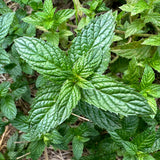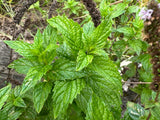Peppermint
Mentha × piperita
Low growing, perennial, aromatic mint with dark green, textured foliage, reddish purple veins and stems, and spurts of purple flowers in late summer and autumn. Grows to between 1-3 feet in height, and flowers attract tons of pollinators!
Believed to be native to Europe and the Middle East, Peppermint has been used as a medicinal and culinary herb since ancient times. Fresh or dried peppermint leaves are often used as an herbal tea or tincture to support digestion or to calm the nerves. It’s used prolifically in culinary flavoring in candy (think candy canes!), jams and sauces, chewing gum, ice cream, toothpaste and other body care and household products. As far as medicinal herbs go, Peppermint may be one of the most popular, even overlooked, in our day-to-day lives.
Peppermint is a cross between watermint and spearmint. As a hybrid, peppermint is often sterile (does not produce seeds). These seeds were harvested from an established patch of what looked and tasted like Peppermint to us, though it may have crossed with an additional mint species along the way! As a mint, it will spread vigorously through the garden via creeping rhizomes. Great contender for growing in a pot or container to restrict its spreading!
Days to maturity: 90
Seeds per pack: 350
Germination rate: 56% on 01/22/2025
Planting / harvesting notes
Sow seeds on the surface of moist potting soil. Do not cover. Tamp down the seeds for good soil contact. Keep it evenly moist and in the sunlight until germination. Start indoors, and later transplant in full sun 10-12" apart. Mint can be a bit of a bully in the garden, and is considered invasive in some regions of the U.S. Consider growing in pots or with barriers to keep it contained as it spreads via vigorous, creeping rhizomes.
Peppermint loves moist habitats, including stream sides and drainage ditches in the wild, and prefers a partial sun to shade area. Will return as a perennial under the right conditions, and with consistent moisture. Commonly propagated from cuttings.
To harvest fresh leaves for medicine, once established, cut the top ⅓ of fresh growth aerial parts any time before flowering. Cut at the node just before the leaves where you are harvesting, to promote regrowth. Cut and come again herb. To dry for medicine, dry leaves quickly (a few days) in a dark, dry place with good airflow. In order to preserve the scent/volatile oils, do not use heat to dry.
Seed keeping notes
After flowering, allow seedheads to dry and turn brown on the plant. Cut the stalks below the lowest seed clusters. If necessary, dry the seedheads further in the sun on a sheet or table away from moisture and precipitation. When fully dry, whack the seedheads in a bucket, allowing the ripest seed to fall. Sift through strainers to remove the largest chaff, and then winnow off the lighter chaff with your breath, a fan, or the wind.









